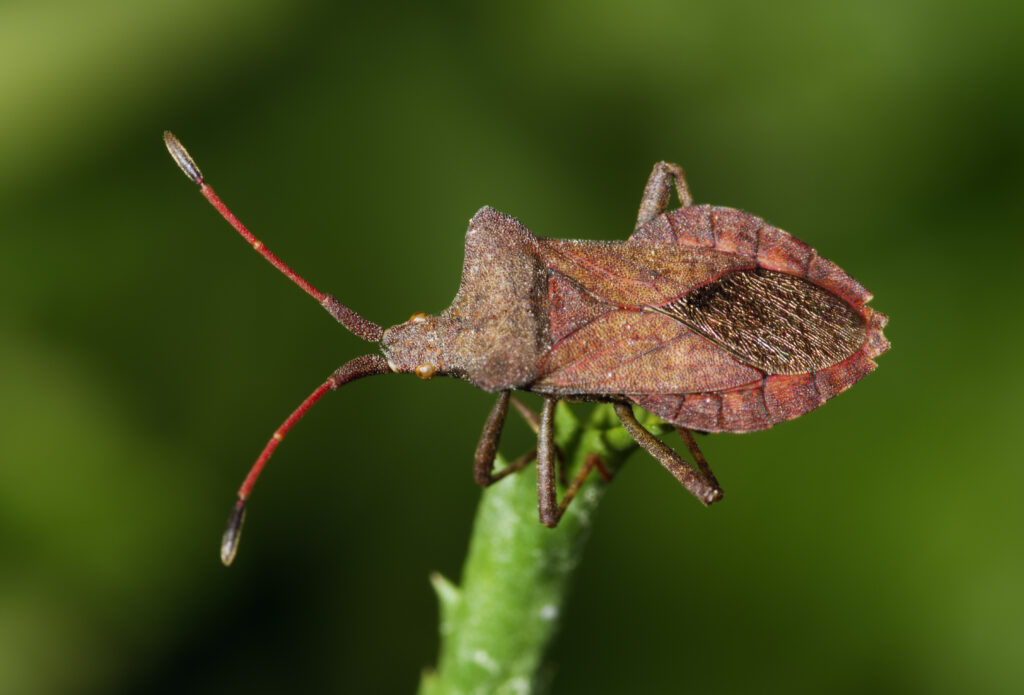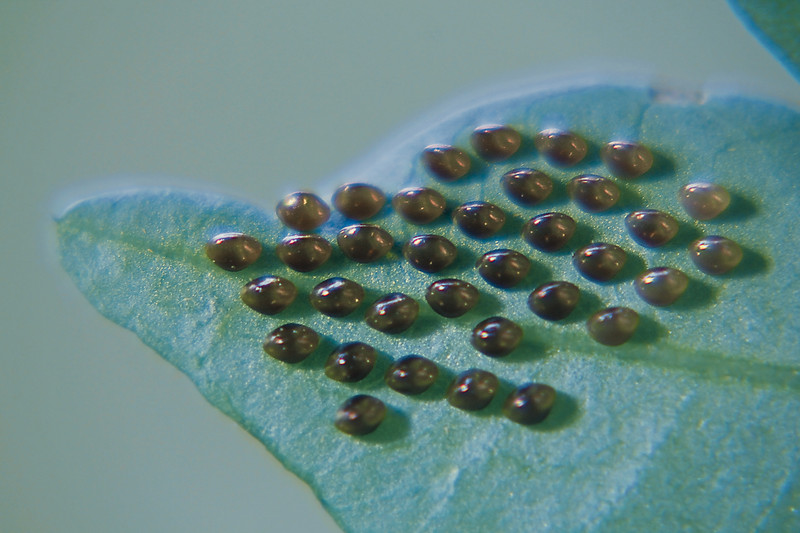Adult and young squash bugs suck the juices from leaves causing leaves to wilt, dry up, and turn brown. Squash bugs commonly attack plants in the cucumber and squash family.
Adult female squash bugs lay eggs from spring through midsummer on the stems and undersides of leaves. The orange-yellow to bronze eggs are elliptical and are often deposited in the angle formed by two plant veins coming together.
Good Products for Pest and Disease Control at Amazon:
- Garden Safe Snail and Slug Bait
- Bonide Sulfur Fungicide
- Monterey BT Caterpillar Killer
- Neem Bliss 100-% Cold Pressed Neem Oil
- Safer Brand Insect Killing Soap
- PyGanic Botanical Insecticide

The eggs hatch after seven to nine days into nymphs and develop through five stages (called instars) into adults. As the nymphs mature they turn from hairy and green to darker-colored and less hairy. Nymphs take all summer to grow into adults.
Unmated adults overwinter under garden litter, vines, or boards to emerge, mate, and lay eggs in spring;
Squash bugs are found throughout North America.
Scientific name: Anasa tritis
Target plants
Squash bugs attack cucumbers, muskmelons, pumpkins, summer and winter squashes, and watermelons. Zucchini is the least susceptible to damage.
Feeding habits and damage
Both adults and nymphs suck plant juices from cucumber family plant crops, especially squash or pumpkins, causing leaves and shoots to develop small specks which turn yellow then turn brown and die back. Vines attacked by squash bugs will not develop from the point of attack to the end of the vine and so fruits will not develop.

Organic controls
Use a barrier to keep bugs off young plants. Apply a preventive spray of insecticidal soap and seaweed extract. Handpick all stages of squash bugs from the undersides of the leaves. Attract native parasitic flies with pollen and nectar plants. If bugs get to the plant, use insecticidal soap. If the infestation is severe, dust the plant with rotenone or sabadilla.
Organic control calendar
Here is what you can do seasonally to control squash bugs:
- Before planting: Plant a trap crop of radishes near cucumber-family plants and handpick or spray bugs as they show up. Place boards around the garden as traps under which squash bugs will hide; seek them out and destroy them. Use a preventive spray of insecticidal soap and seaweed extract in equal parts; apply it to the whole garden when seeds germinate; repeat every two weeks—this will slow the emergence of squash bugs and allow beneficial insects to get a foothold in the garden.
- At planting time: Place spun-poly row covers over new seedlings and transplants to keep squash bugs out. Lay row covers directly on the plants and seal all the edges to the ground with soil—allow enough material for plants to continue to grow. Remove the cover when plants begin to flower.
- While crops develop: Adults emerge about the time vines begin to “run,” or extend beyond the hill. Handpicking bugs regularly; drop the bugs in a bucket of ammonia water. Mash eggs between hard surfaces. Insecticidal soap is an effective control; check plants daily, and spray adults every 2 to 3 days for 2 weeks when adults first appear. Spray adults and nymphs through the season; spray both the tops and undersides of leaves.
- After harvest: Clean the garden of all plant refuse and debris; remove all plants vulnerable to squash bugs. Place the debris in a large clear plastic bag and put the bag in the sun for a week; squash bugs will be destroyed in the heat. Remove boards from the garden which can provide shelter for squash bugs in winter.
Natural predators
Tachinid flies and parasitic wasps prey on squash bug eggs. Animal predators include bluebirds, mockingbirds, and other birds, also turtles.
Squash articles at Harvest to Table:
How to Grow Summer and Winter Squash
How to Plant and Grow Pumpkins
How to Harvest and Store Summer Squash
How to Harvest, Cure, and Store Winter Squash
How to Harvest and Store Pumpkins
Eight Ways to Cook and Serve Summer Squash
Seven Ways to Cook and Serve Winter Squash
How to Make Creamy Pumpkin Soup
How to Cook and Serve Squash Blossoms
Squash Growing Problems: Troubleshooting
Squash Vine Borer Organic Pest Control
Squash Bug Organic Pest Control
Corn, Beans, and Squash: The Three Sisters
Related articles:
Vegetable Garden Organic Pest Control
Vegetable Garden Diseases Problem Solver
Vegetable Garden Organic Weed Control
Garden Planning Books at Amazon:
- Vegetable Garden Almanac & Planner
- Kitchen Garden Grower’s Guide Vegetable Encyclopedia
- Vegetable Garden Grower’s Guide
- Tomato Grower’s Answer Book















